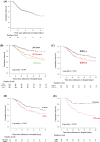Estimation of treatment and prognostic factors of pneumocystis pneumonia in patients with connective tissue diseases
- PMID: 33688083
- PMCID: PMC7944977
- DOI: 10.1136/rmdopen-2020-001508
Estimation of treatment and prognostic factors of pneumocystis pneumonia in patients with connective tissue diseases
Abstract
Objectives: To investigate short-term prognosis and prognostic factors for connective tissue disease-associated pneumocystis pneumonia (CTD-PCP) using the Japanese nationwide diagnosis procedure combination (DPC) inpatient database.
Methods: The present retrospective cohort study from April 2014 to March 2016 included data of patients with CTD-PCP extracted from the DPC database using the 10th revision of International Classification of Diseases and Injuries codes.
Results: In 15 901 766 cases registered from 1329 hospitals, 333 of 67 890 patients who were admitted with PCP were diagnosed with CTD-PCP and included in the study. The median age was 71.0 years, and 214 (64.3%), 80 (24.0%), and 29 (8.7%) patients received sulfamethoxazole/trimethoprim (ST) monotherapy and pentamidine-containing and atovaquone-containing therapy, respectively. There were 114 (34.2%) in-hospital deaths, and the 30-day and 60-day in-hospital survival rates after PCP treatment initiation were 66.0% and 53.7%, respectively. Older age (HR 1.06, 95% CI 1.03 to 1.08) and concomitant interstitial lung disease (ILD) (HR 1.65, 95% CI 1.12 to 2.42) were poor prognostic factors. Patients who completed PCP treatment with ST monotherapy had a significantly higher survival rate than those treated with those not treated with ST monotherapy (p=0.015; log-rank test). Pentamidine versus atovaquone as second-line therapy was significantly higher with atovaquone (p=0.012; log-rank test).
Conclusion: Older age and concomitant ILD were poor prognostic factors for CTD-PCP. ST was a reasonable first-line therapy in patients with CTD-PCP, and patients with inadequate response to ST treated with atovaquone tended to have a better prognosis than those treated with pentamidine.
Keywords: autoimmune diseases; health care; inflammation; outcome assessment.
© Author(s) (or their employer(s)) 2021. Re-use permitted under CC BY-NC. No commercial re-use. See rights and permissions. Published by BMJ.
Conflict of interest statement
Competing interests: YT has received speaking fees and/or honoraria from Daiichi-Sankyo, Astellas, Chugai, Eli Lilly, Pfizer, Abbvie, YL Biologics, Bristol-Myers, Takeda, Mitsubishi-Tanabe, Novartis, Eisai, Janssen, and Teijin and has received research grants from Asahi-kasei, Mitsubishi-Tanabe, Chugai, Takeda, Sanofi, Bristol-Myers, UCB, Daiichi-Sankyo, Eisai, and Ono. KN has received research grants from Mitsubishi-Tanabe, Eli Lilly, and Eisai.
Figures


Similar articles
-
Efficacies of atovaquone, pentamidine, and trimethoprim/sulfamethoxazole for the prevention of Pneumocystis jirovecii pneumonia in patients with connective tissue diseases.J Infect Chemother. 2019 May;25(5):351-354. doi: 10.1016/j.jiac.2019.01.005. Epub 2019 Jan 31. J Infect Chemother. 2019. PMID: 30711257
-
Comparative effectiveness of trimethoprim-sulfamethoxazole versus atovaquone for the prophylaxis of pneumocystis pneumonia in patients with connective tissue diseases receiving prolonged high-dose glucocorticoids.Rheumatol Int. 2022 Aug;42(8):1403-1409. doi: 10.1007/s00296-021-04945-w. Epub 2021 Jul 14. Rheumatol Int. 2022. PMID: 34263352
-
Primary prophylaxis for Pneumocystis jirovecii pneumonia in patients with connective tissue diseases.Semin Arthritis Rheum. 2011 Dec;41(3):497-502. doi: 10.1016/j.semarthrit.2011.05.004. Epub 2011 Sep 29. Semin Arthritis Rheum. 2011. PMID: 21959291
-
The role of atovaquone tablets in treating Pneumocystis carinii pneumonia.J Acquir Immune Defic Syndr Hum Retrovirol. 1995 Mar 1;8(3):247-52. doi: 10.1097/00042560-199503010-00005. J Acquir Immune Defic Syndr Hum Retrovirol. 1995. PMID: 7859136 Review.
-
Clinical, Diagnostic, and Treatment Disparities between HIV-Infected and Non-HIV-Infected Immunocompromised Patients with Pneumocystis jirovecii Pneumonia.Respiration. 2018;96(1):52-65. doi: 10.1159/000487713. Epub 2018 Apr 10. Respiration. 2018. PMID: 29635251 Review.
Cited by
-
Anti-Synthetase Syndrome: A Case Report on the Elevated Risk of Pneumocystosis.Cureus. 2024 Jul 6;16(7):e63982. doi: 10.7759/cureus.63982. eCollection 2024 Jul. Cureus. 2024. PMID: 39104973 Free PMC article.
-
Prognostic Analysis of Pneumocystis Jirovecii Pneumonia in Interstitial Lung Disease Patients: A Retrospective Clinical Study.Diagnostics (Basel). 2022 Nov 23;12(12):2925. doi: 10.3390/diagnostics12122925. Diagnostics (Basel). 2022. PMID: 36552932 Free PMC article.
-
Prophylaxis against pneumocystis pneumonia in rheumatoid arthritis patients treated with b/tsDMARDs: insights from 3787 cases in the FIRST registry.Rheumatology (Oxford). 2022 May 5;61(5):1831-1840. doi: 10.1093/rheumatology/keab647. Rheumatology (Oxford). 2022. PMID: 34382090 Free PMC article.
-
Pneumocystis jiroveci Pneumonia: A Review of Management in Human Immunodeficiency Virus (HIV) and Non-HIV Immunocompromised Patients.Avicenna J Med. 2023 Mar 24;13(1):23-34. doi: 10.1055/s-0043-1764375. eCollection 2023 Jan. Avicenna J Med. 2023. PMID: 36969352 Free PMC article. Review.
-
Short-Term Prognostic Factors in Hospitalized Herpes Zoster Patients and Its Associated Cerebro-Cardiovascular Events: A Nationwide Retrospective Cohort in Japan.Front Med (Lausanne). 2022 Mar 4;9:843809. doi: 10.3389/fmed.2022.843809. eCollection 2022. Front Med (Lausanne). 2022. PMID: 35308501 Free PMC article.
References
MeSH terms
Substances
LinkOut - more resources
Full Text Sources
Other Literature Sources
Medical
Miscellaneous
